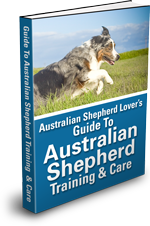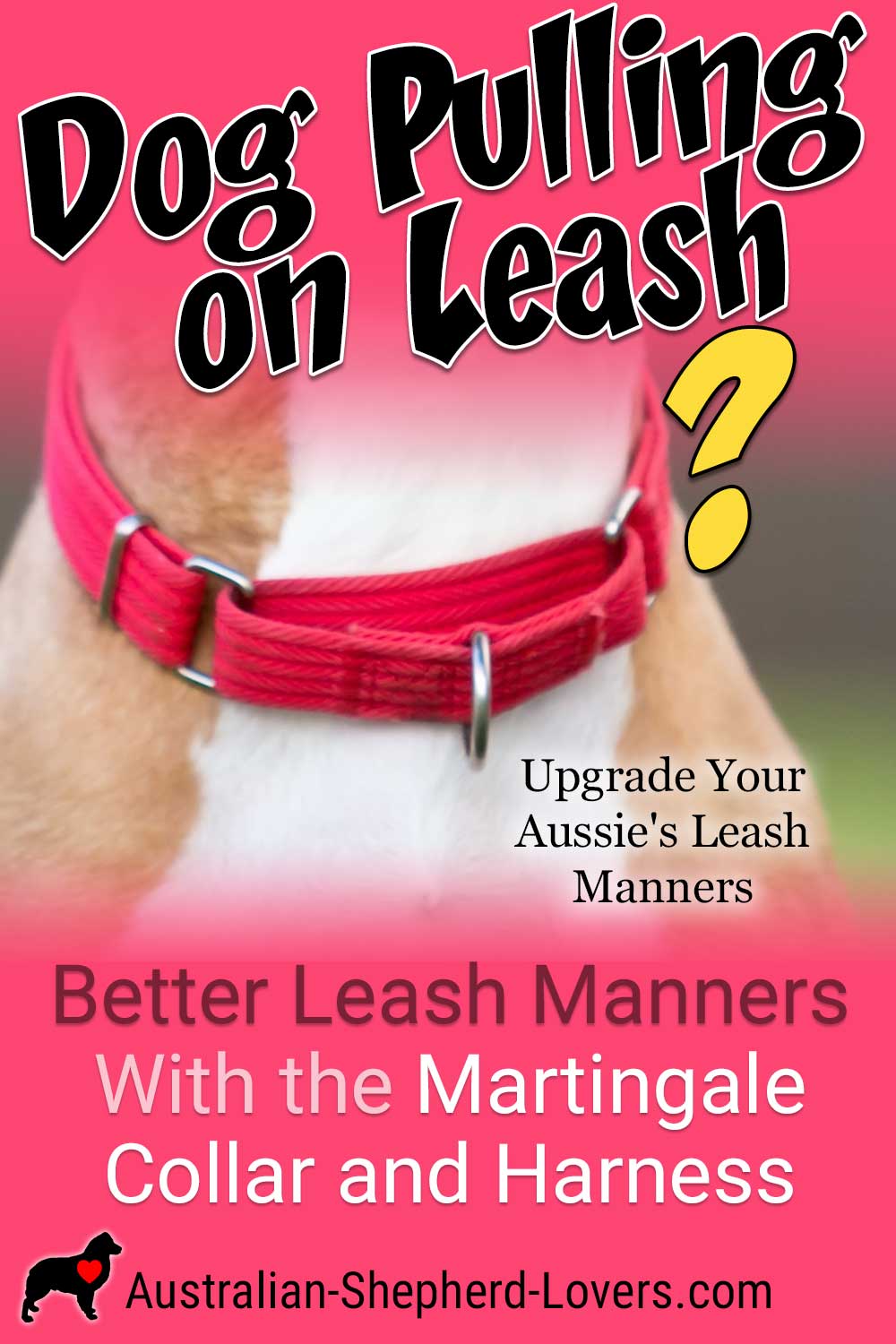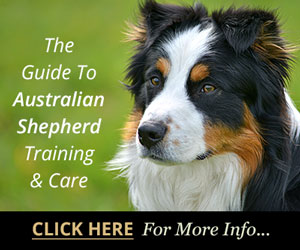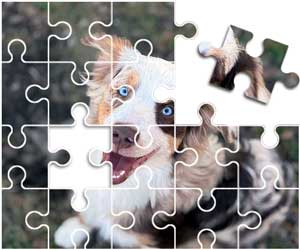
Martingale Dog Collar and Harness—Upgrade Your Aussie's Leash Manners
T he martingale dog collar is a popular and helpful tool, designed to prevent dogs from slipping out of their collar. It can also be used to teach dogs to walk on a loose leash. As with any collar or harness, the effectiveness of the martingale depends on whether it is used properly and how both dog and owner respond to it.
Of course dogs come in many shapes and sizes and for breeds that have a thick neck and small head it can be easy to slip out of a traditional collar. In fact, the martingale was initially designed for sighthounds like Greyhounds and Whippets, whose heads are smaller than their necks. Since then these collars have gained in popularity with owners of other breeds as well.
Dog trainers have also come to rely on the martingale dog collar as a more humane alternative to traditional chain or choke collars. This can be particularly important for breeds like the Australian Shepherd that may pull more than usual when on the leash, which can make a traditional choke collar painful and cruel if not used correctly.
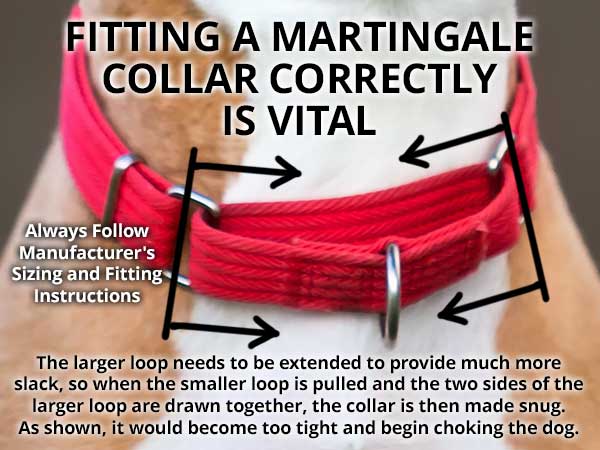
Photo: Mary Swift / stock.adobe.com, Informational Overlay: Anton Hout
Martingale collars work similarly to choke collars. The dog's head goes through a large loop and the leash is attached to a second, smaller loop. When control is required, a tug on the leash will cause the large loop to close enough so that the dog can't slip the collar but not enough to actually choke.
NOTE: The martingale collar shown in the photo above is NOT adjusted correctly and will choke this dog each time the leash is tightened. The large loop should be extended and should be adjusted so that when the leash is pulled, the slack between the two rings is taken up and the collar is snug. At full leash pressure the collar will not tighten beyond snug, so you can still put all your fingers underneath. When there is no leash pressure, the collar should appear loose. ALWAYS FOLLOW MANUFACTURER'S SIZING AND FITTING INSTRUCTIONS.
How Does the Martingale Dog Collar Work?
So what exactly is a martingale dog collar and how does it work? Simply put, it is a collar that consists of two connected loops, one small and one large. The dog's head fits through the larger loop and the clip of the leash attaches to the smaller loop. When the dog pulls on the leash the smaller loop is drawn taut, causing the larger loop to tighten around the dog's neck.
Though it sounds very similar to a choke collar, there is one significant difference when it comes to the martingale dog harness. While the large loop does tighten with pressure on the leash, it can be adjusted so that it will not close tight enough to choke the dog, even if the smaller loop closes completely.
How to Fit a Martingale Collar
In order to ensure a safe fit, the martingale collar needs to be adjusted so that when the large loop pulls to its tightest setting you should still be able to comfortably fit one or two fingers between the collar and your dog's neck. Also, it should only be used when walking your dog on a leash. Do not leave it on them all the time as it can accidentally get caught on things and tighten unintentionally.
While this may seem like a perfect alternative to a choke collar, as with any collar or leash, the martingale can have its drawbacks too, particularly if it isn't used properly. Before deciding whether a martingale is right for your dog, you should carefully weigh all the pros and cons.
Pros:
- Perfect for preventing dogs with large necks and small heads from slipping out of their collar without requiring them to wear a tight collar continually.
- Can be used for leash training as the martingale dog collar will tighten around their neck when they pull on the leash, acting as a deterrent for that kind of unwanted behavior.
- Can be adjusted to the exact size of your dog's neck so it will never become a choking hazard.
- Martingale collars look very similar to regular collars so there is no stigma attached to using them as with other training collars.
Cons:
- Dogs that are very excitable and pull a lot may be in a constant state of discomfort and may come to see it as a form of punishment or form a negative association with the entire idea of walking on the leash.
- For stronger or more aggressive dogs that pull with a lot of force, the martingale can be an injury hazard if the collar is suddenly pulled tight.
- The martingale cannot be used as a training tool by itself. As with any training tool or device, positive reinforcement is also needed in order to train properly.
- A martingale collar can become a health or safety hazard if not sized and used properly so it should never be left on when your dog is unsupervised.
Is a Martingale Dog Collar a Good Choice for Your Dog?
One of the biggest questions most dog owners have is whether a martingale collar or a harness is a better choice for their dog and the answer can come down to several factors. For some breeds, such as Bulldogs and Pugs, collars that may impede their breathing could be a health hazard so a harness may be a better choice.
For stronger breeds that exert more force, a harness can provide more control as it distributes the force and makes it easier on their neck. On the other hand, for dogs that are relatively well behaved but just need a little extra reinforcement to walk properly on a loose leash, the martingale may be the best choice for them.
Known for their intelligence and eagerness to please, Australian Shepherds are particularly good candidates for the martingale. While they can be bundles of energy, Aussies also tend to be more focused and they are very quick to pick up on new commands or skills, so they don't require a huge amount of training. The subtle tug of a well-fitting martingale may be all that's needed to get the message across and improve their on-leash behavior dramatically.
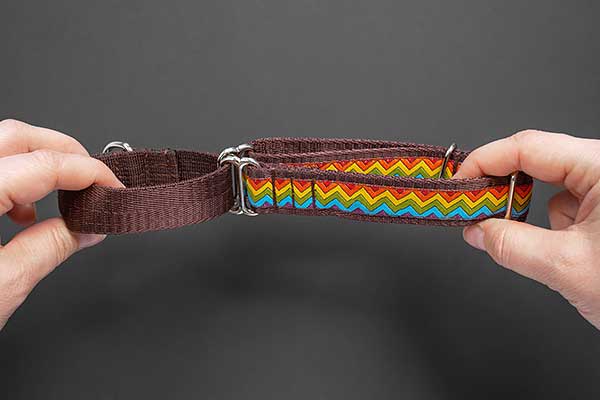
Masarik / stock.adobe.com
When the dog pulls on the leash the smaller loop is drawn taut, causing the larger loop to tighten around the dog's neck.
What's the Difference Between a Martingale Collar and a Martingale Harness
A martingale collar and a martingale harness are both designed for dog training and control, but they have some key differences in their design and function.
Design:
A martingale collar is a type of dog collar that consists of a larger loop and a smaller control loop. The larger loop fits around the dog's neck, while the smaller control loop tightens when pulled, preventing the dog from slipping out of the collar. This design is particularly useful for dogs with narrow heads or those who tend to back out of traditional collars.
A martingale harness, on the other hand, has a similar tightening mechanism but is designed to fit around the dog's chest and shoulders, distributing pressure more evenly across the body. The martingale function is usually integrated into the chest strap, which tightens when pulled to prevent the dog from slipping out.
Pressure Distribution:
Since the collar tightens around the dog's neck when pulled, it can create pressure on the dog's throat, potentially leading to coughing, gagging, or injury if not used correctly. This is why it is important to size the larger loop correctly when you are fitting it for your dog.
The harness distributes pressure more evenly across the dog's chest and shoulders, reducing the risk of injury and discomfort. This design can be particularly beneficial for dogs with respiratory issues or sensitive tracheas.
Control:
Martingale collars are generally effective for providing control during walks and training sessions, but they may not be sufficient for strong pullers or dogs with behavioral issues.
Martingale harnesses can provide better control for dogs that pull, as the pressure is applied to the chest area, which is more effective in controlling a dog's movement. This can be particularly helpful for larger or more powerful dogs.
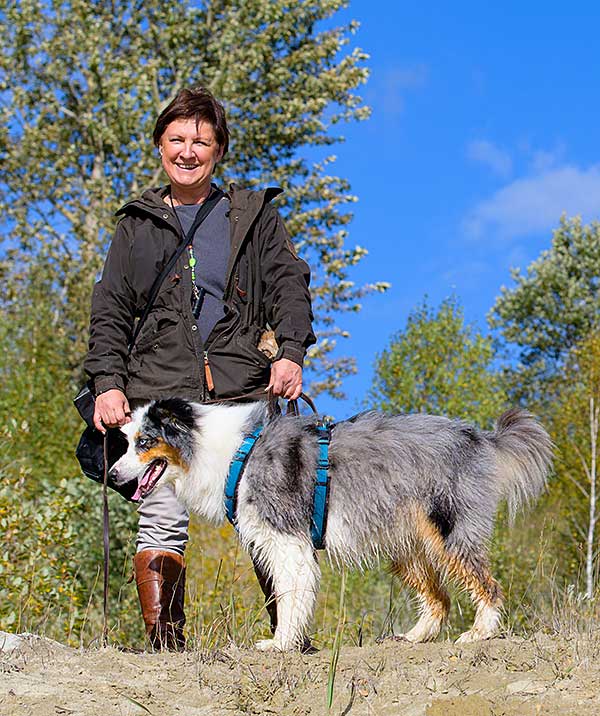
motivjaegerin1 / stock.adobe.com
Whether you use a collar or a harness, the same principle of the "martingale loop" is used in both.
The Martingale Dog Collar and Harness Will Both Serve You Well
In summary, the main difference between a martingale collar and a martingale harness lies in their design and the way they distribute pressure on a dog's body.
Martingale collars are primairly designed for dogs with narrow heads or those who slip out of traditional collars, but they also work well for most breeds including the Australian Shepherd.
On the other hand martingale harnesses offer better control and distribute pressure more evenly across the chest and shoulders, making them suitable for dogs that pull or have sensitive tracheas.
As a cruelty-free alternative to prevent escaping and encourage proper leash training, either the martingale dog collar or harness can be a great choice. There are many options available on the market, most made of rugged nylon so that they will stand up to even the most active dog. So shop wisely and make the right decision for you and your dog and you'll both be able to enjoy safer and happier adventures together.
*This article was written using OpenAI's ChatGPT only as a research tool and writing assistant. Any generated text is reviewed by the author, edited, and revised where necessary. The author takes ultimate responsibility for the content of this article.
Have Dog Training Questions?
Check out these introductory dog training videos...
I want my dog to stop being aggressive.
I want some help training my new puppy.
I want my dog to stop barking at everything.
Get Australian Shepherd Info, Website Updates, Special Offers, and Cartoons...
FREE GIFT
You'll also receive a free copy of the ebook
My Everyday Dog Training Tools
by professional dog trainer Daniel Abdelnoor, "Doggy Dan"
